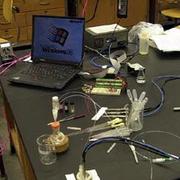If you ask Anthony Wong, a sophomore at Carleton College, noses don't get the respect they deserve. The technology that has been developed to simulate the senses has neglected smell, one of life's most important – and evolutionarily oldest – senses, he points out. "We have created cameras that act as artificial eyes and microphones that act as artificial ears, but we have yet to develop an artificial nose," he said.
This summer, Wong and Associate Professor of Chemistry Steve Drew have been bridging that gap by developing an electronic nose in Carleton's chemistry laboratories. Their work, based on Drew's previous sabbatical research at the University of Minnesota with Professor of Chemistry Kent Mann, will help manufacturers determine the best way to package and preserve everyday foods such as muffins and bagels and protect industrial workers from harmful vapors. The research is funded by a grant from the Research Site for Educators in Chemistry program, administered by the University of Minnesota and the National Science Foundation.
Bearing no resemblance to a human nose, the electronic nose is really a metallic box called a flow cell. Photos by Jonathan Kayes '04 Inside the flow cell, three platinum double salt compounds are embedded in three small wells. Sensitive to their atmosphere, the compounds change color when they come into contact with different kinds of vapor; each vapor elicits a unique color from each compound. Light sensors measure the light emitted from the surface of the compounds while a computer connected to the sensors records the emission intensity in the form of a spectrum.
The combined three spectra from the three sensor compounds serve as virtual fingerprints for the gases, enabling scientists to identify a given gas with the aid of a computer.
Wong, a chemistry major, became interested in this research during a conversation he had with Drew as a student in Drew's Equilibrium and Analysis course last fall. "I was excited by the chance to combine my interest in chemistry with my interest in computer programming," Wong said.
Previous course work in computer science enabled Wong to develop software to acquire and process the data from the electronic nose's light sensors. Earlier versions of the electronic nose used a large, expensive light sensor (for example, a spectrometer), and had to process the sensor's data without the assistance of dedicated software, rendering the apparatus too large and costly for large scale, commercial use. Using the programming language LABVIEW, Wong wrote a computer program that records the three emission spectra from the flow cell's three platinum double salt compounds using a single, inexpensive spectrometer. Because the bulk of the data processing now occurs on a laptop computer interfaced to an inexpensive spectrometer, the device is now portable and less costly.
Wong also has helped to refine the instrument's use. He has spent much of the summer searching for platinum double salt compounds whose color will respond to changes in humidity levels, work that will directly benefit food manufacturers. With the ability to measure and monitor the humidity levels of their foods before packaging, food manufacturers will be able to preserve the freshness of their products for longer periods of time.
Drew and Wong hope to include the data gathered this summer in an article that they are preparing for the scientific journal "Sensors and Actuators." In the future, Drew hopes to enhance the nose's ability to detect vapors that are optical isomers, molecules that have the same composition but different three-dimensional shapes. The molecule carvone, for instance, smells like spearmint in one isomeric form and caraway in another. "We are going to attempt to design a sensor that can differentiate between optically active vapors to see if we can mimic what a human nose can already do," Drew said.
In addition to helping the food manufacturing industry, Wong hopes the research he has conducted this summer with Drew will have other future practical applications. The electronic nose's ability to detect gases could potentially help safety and security professionals detect toxic substances, contain contaminated areas, and prevent the illegal use of toxins.



